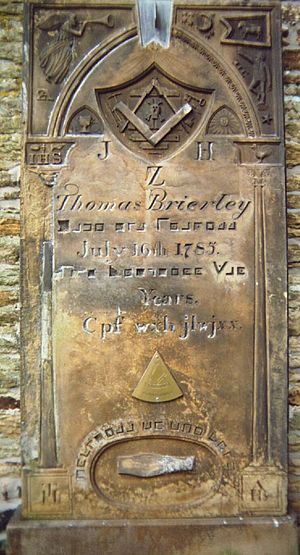Thomas Brierley grave cipher facts for kids
Thomas Brierley (born 1785, died 1855) has a very special gravestone in Mellor, Greater Manchester. It's one of the only gravestones in the United Kingdom that uses a secret code. This code is called a pigpen cipher, and it was used by a group called the Freemasons. Another gravestone with this code is in West Huntspill, belonging to John Jennings.
Contents
Thomas Brierley's Story
Early Life and Work
Thomas Brierley was born on July 16, 1785, in Mellor. His parents were Joab Brierley and Betty Arnfield. People sometimes called him "Tommy."
He worked as a printer at a mill in Strines, Manchester. There, he printed patterns on a type of cloth called calico. Later, he became a carter. This meant he moved goods between places like Ludworth and Disley.
Joining the Freemasons
Thomas Brierley was a regular member of the Freemason Lodge of Union. Records show he attended meetings between 1824 and 1830, and again from 1840 to 1848. The Lodge moved from Manchester to Mellor in 1822.
The group met in different places, including the Devonshire Arms and the Shuttle Inn (which later became the George). About 20 members usually attended each meeting. Most of them were miners or small business owners. Thomas was also in charge of the money for the Royal Arch chapter, which started in 1824. He was also part of other Freemason groups.
The Unique Burial Plan
The Stone Coffin Mystery
Thomas Brierley sometimes felt unwell. He used money from his Freemason group when he was sick. Some members thought he was pretending to be ill, especially when work was slow at the printworks. This made Thomas very sad, as he was known as an honest man.
Because of this, Thomas had a special stone coffin made. A local stonemason named Azariah Ollerenshaw made it. Thomas even lay down in the coffin so it could be cut to fit him perfectly! Some stories say the Duke of Devonshire had the coffin made for Thomas when he heard he was sick.
The coffin was placed outside on his grave site at St. Thomas' Church in Mellor. It had Masonic symbols carved on the lid. Underneath, it said, "I am belied," meaning "I am lied about." This was likely about the accusations of faking his illness. The coffin stayed there for years and became a popular sight. But it caused too much attention for the local vicar, Rev. Matthew Freeman. He ordered the coffin to be buried, and it is believed to still be just below the ground.
The Special Headstone
Thomas didn't let this stop him. He had a memorial headstone made with secret 'cipher-writings' and fancy Masonic symbols. He placed it over his grave before he died.
There was talk of burying him in his stone coffin. But it was too heavy to move to his house. Also, it wasn't common to take a body to a coffin already in the grave. So, Thomas was buried in a wooden coffin, probably next to the stone one.
Unlocking the Secret Messages
What the Ciphers Say
For many years, the secret code on Thomas Brierley's headstone was a mystery. The headstone actually uses five different types of pigpen ciphers.
At the top of the stone, the code says: "Thomas Brierley made his ingress July 16th 1785, His Progress was ____ Years And his Egress___". This means "Thomas Brierley was born July 16th 1785, He lived for ____ Years And he died___". The headstone was never fully finished after he passed away.
At the bottom of the gravestone, the cipher says "Holiness of the Lord."
The Pigpen Cipher Puzzle
Freemasons used the pigpen cipher in the 1700s to keep their records private. The cipher on Thomas Brierley's grave is a bit unusual. It has a different symbol for the letter "S." This unique symbol might be a clue or a key to other documents Thomas handled as the group's treasurer.
When the headstone was first put up, people thought the code contained the old accusations against him. They also believed it was written in Hebrew to stop anyone from complaining about it being placed there while Thomas was still alive. Newspaper reports even said this. One visitor even claimed it was Greek, but then admitted it was a type of Greek he hadn't learned in university!
More Mysteries and Legends
Some stories say Thomas Brierley fell to his death from the church tower. However, other sources disagree, so this might just be a local legend. Adding to the mystery, a bronze plaque with more cipher writing was added to the stone recently. This new cipher is similar but not exactly the same as the original.
Thomas Brierley died in 1855. He was buried in Mellor Churchyard on July 26 of that year.
Images for kids



